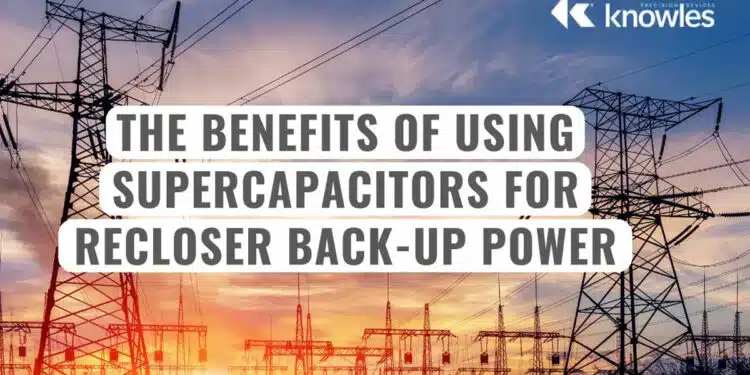This article based on Knowles Precision Devices blog explains benefits of supercapacitors in recliner back-up power supplies applications.
To protect electrical grids from overloads and faults, utility companies can incorporate reclosers.
When a fault occurs, this high-voltage circuit breaker automatically closes to isolate the faulty sections of the grid, allowing other areas of the grid to continue to operate safely.
The recloser can then automatically test the electrical lines to determine if the issue has been resolved and reset itself, restoring power more quickly once a fault is cleared. Reclosers are also designed to perform remote switching, enabling utilities to manage their networks more efficiently.
To ensure the recloser remains operational during a power outage or low-voltage conditions, a temporary power source, such as a battery, is needed. Without a backup power source, a recloser would not be able to function. Batteries are commonly used as the backup power source for reclosers because the battery power enables the device to rapidly switch in and out, preventing damage to equipment and ensuring public safety.
However, there are some challenges with using batteries as a backup power source for reclosers. In general, batteries have a limited number of charge/discharge cycles and will degrade over time, reducing overall performance and reliability.
This is especially true when batteries are repeatedly exposed to extreme cold or heat. As a result, most recloser manufacturers recommend replacing batteries every five years, which can be costly. Beyond the expense of battery replacement, it can also be a logistically challenging task to perform, especially in remote locations. Therefore, a battery management system is required for reclosers as a method for managing the ongoing monitoring and maintenance required to ensure optimal performance, adding to the overall operations and maintenance expenses for the grid.
Swapping Batteries for Supercapacitors
Supercapacitors are now an option for offering an alternative power storage solution for reclosers. Including a supercapacitor instead of a battery for backup power, can offer many benefits, including the following:
- High power density and the ability to store energy electrostatically enables rapid charge/discharge cycles
- With mechanical and chemical degradation that is less severe than a battery, supercapacitors have a much longer lifespan than traditional batteries
- A wider operating temperature range versus most battery types allows supercapacitor to function without significant degradation in environments ranging from -40°C to 70°C
- Biodegradable nature makes waste disposal easier
- High efficiency, with minimal energy loss during charging cycles compared to traditional batteries
Overall, supercapacitors offer a promising alternative to traditional battery backup for reclosers used in power grids with advantages in terms of power density, lifespan, operating temperature range, eco-friendliness, and efficiency.






























